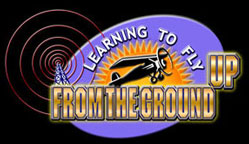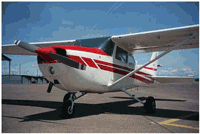My flight instructor is a big man. Robert Scott tips the altimeter at something like six-four, and has a ramp weight of over 260 pounds. So when I took off without him in the second seat for the first time, I noticed some pleasant differences. The Cessna 172 Skyhawk took off more quickly, the handling was easier, and without my over-sized instructor sitting beside me, more sunshine came in, and I was provided with a much fuller field of vision.
Yes, Captain Scott was back on the ground, watching me in my first solo. With the less weight in the aircraft, I reached the point to turn into the crosswind leg more quickly, and found that I was climbing faster to the pattern altitude. I pulled back on the power and in a few seconds began my turn into the downwind leg. I was a-mile- and-a-half from and parallel to Runway three-four.
I called the tower to tell them where I was and my plan to stop-’n-go, i.e., to land the plane bringing it to a full stop on the centerline of the runway, and then to take off again. The tower knew already and was watching; Captain Scott had informed the tower that I was a student on my first solo.
If I had thought about the fact that this was my first solo -- that I was 1500 feet above the ground alone, with no one to help if I got into trouble — I might have alarmed myself a little bit. But I truly wasn’t worried, and I eased the thought out of my mind. I focused on the flying.
Crossing even with the threshold of the runway, I pulled on the carburetor heat, pulled back on the throttle, and lowered the flaps ten degrees. When I was ready to turn onto my base leg, I looked back easily through the unblocked right window to see that I was indeed at a 45-degree angle to the runway. It was the first time I’d ever had such a view.
I lowered the flaps to 20-degrees, and banked toward the approach, dipping the nose as I entered the base leg. Again I was aware of the thought about this being my first solo, this thought trying to gain my attention, but I smiled it away as I checked my altimeter and airspeed.
As I write this account, I can remember how foreign it all seemed to me just a few months ago. There was so much information, so many gauges to watch, power, pitch, and attitude to control, all the while checking for other planes. I didn’t have an understanding of what I was doing, let alone was I comfortable with instruments and functions.
But I had gotten comfortable, finally and suddenly, a week earlier. It was when I had taken control of the aircraft. So when I had finished my pre-flight that morning and climbed into the pilot’s seat, I was engaging the plane rather than being just being a student passenger.
I didn’t know when I arrived at the airport that morning that I would be soloing that day. My instructor and I had talked about it. But there was a considerable breeze — fifteen knots with gusts to twenty — and neither he nor I was going to put me up in the plane alone without us both being sure. And I certainly didn’t have to ask him, since he wouldn’t take a chance with either me or the aircraft.
So Captain Scott and I had taken off and done five stop-’n-go’s. After the last one, he told me to drop him off at the terminal. I taxied out to the point just shy of the runway where we would turn into the wind and do our run-up. Not having shut off the engine when my instructor got out, I didn’t think that I had to go through the procedure of revving up the engine and checking out the gauges again, but not sure, I did it anyway.
Then clearance from the tower and I was on my own. I taxied onto the runway, and without stopping, turned onto the center line and accelerated. I kept the left aileron up slightly for the wind coming across the runway, and using the pedals and the rudder, kept the nose on the center line. I watched the airspeed climb. At 50 knots, I raised the nose into the air. Seconds later, as the airspeed climbed past 65, the rest of the plane followed.
I had always liked take-offs, and had taken to executing them well months before I got the landing concept into my head and body. I don’t know that learning to land took longer than it should to learn; it took the time it took. Now I was going to make a landing alone for the first time. There would be no one sitting there shouting out corrections to my attitude and altitude, speed and angle.
On the base leg, it took significant crabbing to hold position against the twenty knots of wind a thousand feet above the ground. I took advantage of the currents and dropped six hundred feet closer to the field. While my left hand gently but firmly controlled the wheel, my right hand was pushing in the throttle to add speed to the final leg.
With my airspeed below 85 knots, I lowered the flaps to their full 30-degrees. Seeing the two red-two white lights of the indicators, I knew what I already knew from my position above the ground, that I was right on glide path. I needed more power heading into the wind; I slid the throttle in smoothly.
My instructor said that I would notice his absence on both take-off and landing, and he was right. The plane wanted to fly more, but like a well-trained colt it responded impeccably to my touch.
I checked my nerves but couldn’t find a glimmer of concern. Where there might have been trepidation was a sense of grounded excitement. The feeling inside of knowing that I had what I needed to pass this test. The confident reaching forward, not to attain a goal, but to rise through a doorway to a limitless future.
As I crossed the threshold twenty feet above the runway, I felt a crosswind push me off the centerline just as I was closing the throttle. I had time to do a go-round; I knew the plane would respond if I pushed in the throttle again. But I didn’t need to. I had the 70 knots I needed.
I tweaked the ailerons and pushed on the right rudder pedal. The plane drifted back to centerline, then across, then back again. Just as I flared toward landing position, a buffet of air lifted us up from the descent. I eased back slowly on the yoke to control the glide back down. Seconds later the wheels hit the tarmac. Firm, I think would be a fair description, and probably a three-foot bounce.
But only one. I let the nose come down, keeping it on the center line, and brought the plane to a stop. In went the carb heat, up went the flaps, and then I pushed in the throttle; moments later I was airborne again. The second go-round was flown without any major observable errors, this time by a pilot who had already soloed.
On the downwind leg, I told the tower I was coming in for a full stop. That was fine with them, but they did want me to extend my downwind just a shade to accommodate a Brasilia that was making a scheduled landing. Oh, and watch out for ground turbulence when I came in.
Watching where the Brasilia landed so I could calculate my touchdown point, I extended the downwind leg less than a mile before turning into the base leg. Then a comfortable turn to final approach, with a little extra time to watch the glide slope indicators show two white and two red. It wasn’t as though I had to wait for the runway, but suddenly this window in time opened up, and I owned what I had done. What I could do.
Another little windy bounce on landing, and then I taxied back to the terminal. There I saw my instructor standing outside waiting for me, both arms raised, giving me two thumbs up. And with him were my wife and radio partner. I hadn’t known they were coming, and was pleased and honored by their attendance. They had watched the whole morning, and had hidden when I brought my instructor back.
I shut down the plane and climbed out. A long hug for my instructor, and one for my wife. There was a bottle of champagne to be opened, and crystal glasses to celebrate this accomplishment, right there by the taxiway. And photos with the plane. But first, rather suddenly, I felt my shirt being pulled out of the back of my jeans and then ripped. No, I hadn’t known about this custom. Soon a piece of autographed cranberry broadcloth will be on the wall of my study.
Before imbibing, we put the Skyhawk back in the hanger. I knew I would be with her again soon. There was much yet to learn, including flying at night. And I was looking forward to the hours that would mean being in that plane again, flying away from the ground, to reach up, and as John Gillespie Magee put it, "to touch the face of God."
On June 27th 1999 I flew alone for the first time. Here is the story of that flight. This article was printed in the May 2000 issue of "Flight Training" magazine, which is published by the AOPA (Aircraft Owners and Pilots Association), which with its 350,000 members is a powerful voice on issues pertaining to general aviation.








